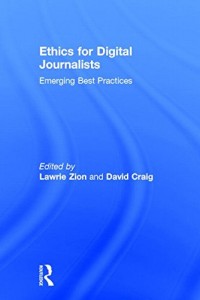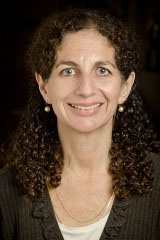Observations of 15 media scholars from seven countries
Hardcover: 240 pages; Publisher: Routledge (Sept. 18, 2014)
Reviewed by Carolyn Schurr Levin
 Because the ethics of online journalism has created so much debate, hand wringing, and frustration, and because I teach a course in Media Ethics every semester, I was especially anxious to read the collaboration of “emerging best practices,” set forth in the recently released Ethics for Digital Journalists: Emerging Best Practices, edited by Lawrie Zion, associate professor of journalism at La Trobe University in Melbourne, Australia, and David Craig, professor and associate dean at Gaylord College of Journalism and Mass Communication at the University of Oklahoma.
Because the ethics of online journalism has created so much debate, hand wringing, and frustration, and because I teach a course in Media Ethics every semester, I was especially anxious to read the collaboration of “emerging best practices,” set forth in the recently released Ethics for Digital Journalists: Emerging Best Practices, edited by Lawrie Zion, associate professor of journalism at La Trobe University in Melbourne, Australia, and David Craig, professor and associate dean at Gaylord College of Journalism and Mass Communication at the University of Oklahoma.
In this thoroughly researched work, 15 journalism professors and media scholars from seven countries have joined together to connect ethical principles with in-depth guidance on best practices in a wide range of areas. Each contributor has a chapter, with chapter titles including “Fostering and Moderating Citizen Conversations,” “The Case for Curatorial Journalism…Or, Can You Really Be an Ethical Aggregator?,” “Live Tweeting: The Rise of Real-Time Reporting,” and “Data Journalism.”
The compilation provides guidance that can be applied, in many instances, to all forms of media, not solely to digital media, as its title implies. As Craig points out in his chapter on “Journalism Ethics and Best Practices,” “The pursuit of best practices in digital media can be related to three major emphases in ethical thought: duty, virtue, and care,” all of which, of course, are ethical precepts essential to good journalism in any form.”
Also. despite the implications of its title, this is not a “how to” book. Rather, each author investigates his or her topic, starting with the historical context, going back in some cases to Aristotle or Immanuel Kant, and then delving into best practices in action. They frequently use a recent ethical lapse as a teaching example, and conclude chapters with discussion questions and references.
Some of the most informative chapters in the book provide insight into recent news events. Alfred Hermida, devotes the “Best Practices in Action” section in his “Filtering Fact From Fiction” chapter to the Boston Marathon Bombings. Hermida is an associate professor of journalism at the Graduate School of Journalism of the University of British Columbia and a 16-year veteran of the BBC.
Hermida reminds readers who closely followed the breaking news on April 15, 2013, of “the rumors, misinformation, and reporting errors that flowed on news outlets and social media in the hours and days following the Boston Marathon bombings.” He points out just some of the multitude of errors that were made:
“CNN and other news organizations reported an arrest when there was none. The New York Post mistakenly identified two men in a front page photo and said they were wanted by law enforcement. And “Twitter and Reddit came under fire for fanning the flames of speculation.”
But, then Hermida offers a remedy, six bullet points of “Best Practices” to lessen these types of ethical lapses in a breaking news situation, where events are in constant motion and there is considerable potential for the reporting to be messy:
- Be precise in your reporting.
- Be clear about what you know but also about what you don’t know.
- Be careful to place new information in context, acknowledging the source and its reliability.
- Be aware that people will want to talk about the news, share what they know, and want to help.
- Be mindful that exchanges on social media are not the equivalent of publication.
- Be conscious of the emotional impact of an event.
While none of these “Best Practices” is new, and clearly all of them can be applied to traditional forms of media as well as digital media, placing them in the context of the Boston Marathon Bombings is a reminder of the importance of best ethical practices in the public arena of the internet where breaking news is often based on unverified information.
One of the other provocative chapters in the compilation is “Handling Mistakes: Corrections and Unpublishing,” by Tim Currie, professor of journalism at the University of King’s College in Halifax, Canada. Currie begins his chapter with this ethical lapse: “In the heady moments following the mass killing at the Washington Navy Yard in September 2013, journalists from both NBC and CBS rushed to identify the shooter on Twitter – but named the wrong person.” Currie explains that the newsrooms realized their mistake within minutes and the journalists retweeted a retraction.
Then he asks, “How can journalists better use evolving platforms to limit the effect of errors?” Relying upon basic ethical concepts of duty, virtue, care, and humility in acknowledging error, and an additional ethical concept of “the importance of care in using social media to minimize harm,” Currie suggests that journalists can build a stronger relationship with their audience both before and after things go wrong.
Relying upon the Canadian Association of Journalists’ guidelines for making digital corrections, Currie stresses the importance of transparency, visibility, timeliness, engagement, and thoroughness. While again, these are time-honored concepts for all journalists, perhaps the nature of social media requires that we remind ourselves of them more frequently.
A third Canadian contributor, Juliette De Maeyer, an assistant professor in the Department of Communications at the Universite de Montreal, explores “Best Practices for Linking.” Although linking can no longer be considered new, and has in fact been extensively debated since the late 1990s, De Maeyer offers what she refers to as the “ethic of the link,” emphasizing all the good that can come from links: “Links can be used by journalists to increase transparency, to ensure correct attribution and sourcing, and to promote openness.”
On the other hand, De Maeyer argues, “Any website that is linked to can change over time or disappear.” Stability is a concern that should be considered when linking to external content, she cautions.
De Maeyer’s “Best Practices” section is devoted to “Linking to Wikipedia,” a practice that evokes strong opinions on all sides. She suggests using Wikipedia links to provide context in a news story can become a circular, self-referential phenomenon, which, at worst, could lead to factual errors. While she forcefully lays out the ethical dilemmas, De Maeyer makes clear that there is no panacea or quick fix. She does, however, raise important questions that should be considered before linking: “Will the links you provide enrich the experience for your audience? Would the story make sense without the link?”
Unfortunately, each of the thought-provoking chapters in this compilation cannot possibly be evaluated in an abbreviated review. Yet, the remaining chapters follow the same format, providing historical context, ethical dilemmas, best practices, discussion questions, and extensive references for a wide range of issues relevant to the daily work of digital journalists.
This book will not end the debate about whether ethics is a quaint old-fashioned concept in the new, fast-paced media landscape; nor does it purport to have all of the answers. What it does well, co-editor Zion suggests, is to explore areas in which “traditional [ethical] codes often lag behind media practices, especially when content is produced outside of the institutional norms, processes, and structures of traditional media.”
The book provides worthwhile insight for those journalists and academics who still believe – as I do – that no matter what the form of media or how fast the story is breaking, it is always important to digest and consider all available ethical guidance in order to get it right.

Carolyn Schurr Levin is an attorney specializing in Media Law and the First Amendment. She has practiced law for over 20 years, including as the Vice President and General Counsel of Ziff Davis Media, the Vice President and General Counsel of Newsday, a Litigation Associate at Corbin Silverman and Sanseverino, and a Litigation Associate at Cravath, Swaine & Moore. She is admitted to the bars of New York, Connecticut and the District of Columbia. Levin also teaches Media Law and other related courses at the C.W. Post campus of Long Island University. Levin has also taught a graduate level course in Legal Aspects of Publishing at Pace University in New York City. As a freelance writer, Levin has been published in the New York Times Book Review, New York Law Journal, American Bar Association Journal, Corporate Counsel newsletter, Barrister magazine, and Special Counsel newsletter. Levin earned a J.D. from the University of Chicago Law School, a B.A. from Johns Hopkins University, and a Certificate in Journalism from New York University.
